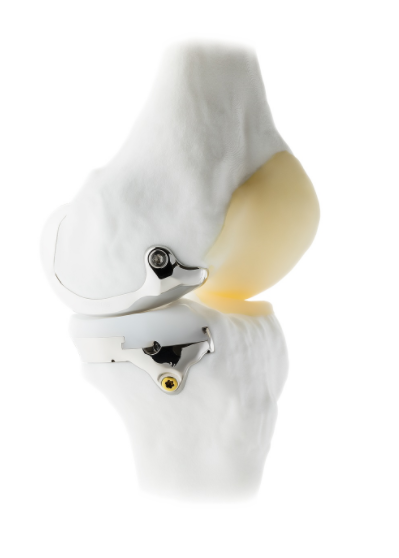
Additive manufacturing (AM) is revolutionizing a variety of industries, and healthcare is ripe for transformation. According to SME, the 3D printed medical devices market is expected to near $26 billion over the next two years. Moreover, the medical sector already accounts for 17 percent of the total AM market, and the market share is expected to grow as even more manufacturers expand beyond prototyping.
Simply put: If you’re not yet utilizing 3D printing, you’re behind the competition.
Thanks to the flexible nature of AM, manufacturers are no longer beholden to large-series productions. With 3D printing, you can help medical providers develop equipment and tools with intricate designs and geometries, allow them to better react to condensed delivery times and financial barriers, and provide functional integration — all with a patient care journey that’s more personalized than ever before.
Personalized healthcare represents one of the most significant areas of growth potential in the medical space. Using 3D printing to personalize products, tools, and devices enables you to cater to the physiological and functional aspects of individual patients and medical staff.

For example, providing customized surgical tools can enhance procedures and improve a surgeon’s dexterity or ability to serve a specific patient population. A surgeon might naturally hold a tool or device in a way that’s not standard because of their grip preference, hand size, or other physiological differences. They could also have a special surgical technique for a particular patient population which could be better served by a tool designed to meet their technique, instead of forcing them to adapt to mass-produced instruments intended for a broad patient population.
On the patient side, healthcare providers can manufacture medical devices to the exact specifications of patients. Take, for instance, customized cutting guides for knee replacements, which allow surgeons to prep and operate quicker, as well as promote recovery and healing in patients. With AM, doctors can also create functional prototypes representing a patient’s exact circumstances so they can plan operations, test different scenarios, or economically test pharmaceutical treatments.

Today’s healthcare providers are accomplishing the previously unimaginable: from incredible advancements in research for 3D printed organs and artificial bones to prosthetic limbs for para-athletes and beyond. Many 3D printed structures can even help promote the growth of tissue or replicate more complex cavities not possible with traditional injection-molded or extrusion methods.
Now is the time for manufacturers to take advantage of this growing space. And your success boils down to your approach and ability to find the best solutions to fit patient needs.
One of the common roadblocks preventing more widespread use and adoption of 3D printing is not reviewing the technology from the broad impact it can have on an organization. Focusing on one product line or use case can create roadblocks in the future when trying to multiply the technology to other platforms or new business models. For example, not thinking about the full scope of products in the pipeline when adding additive manufacturing into a quality system can cause unanticipated work for the next product’s roadmap.

EOS GmbH Krailling Photo: Tobias Hase (www.hase-fotografie.de)
Instead, approaching AM from a holistic perspective enables management to identify critical areas throughout the organization where 3D printing can improve operations. For this approach to be successful, key decision-makers and department heads representing multiple disciplines or business units need to be involved in the implementation process from the beginning.
From cutting-edge materials to high-value applications, the medical industry is prime for additive manufacturing to flourish. Learn more by attending my session, “Fireside chat: Emerging trends for 3D printing in healthcare,” on Tuesday, Feb. 11th at 10:10 a.m. during Additive Manufacturing Strategies 2020.
Laura Gilmour is the Global Medical Business Development Manager for EOS, the world’s leading technology supplier in the field of industrial 3D printing of metals and polymers. For more information, visit www.eos.info/en/.
Subscribe to Our Email Newsletter
Stay up-to-date on all the latest news from the 3D printing industry and receive information and offers from third party vendors.
Print Services
Upload your 3D Models and get them printed quickly and efficiently.
You May Also Like
Srini Kaza Discusses Strategically Scaling Align’s “Smile-Changing” 3D Printed Aligners
Align Technology‘s Invisalign is a revolutionary method to get you the smile you want through 3D printing. It is also a hugely popular process to go through, a $4 billion...
Zhejiang University Researchers Potentially Develop Sustainable Closed Loop Resins
Zhejiang University researchers have come up with a thrilling discovery that could make resins much more sustainable. In a paper for Science, “Circular 3D printing of high-performance photopolymers through dissociative...
3D Printing News Briefs, July 23, 2025: ASTM Standard, Defense, Bioinks, & More
We’re starting with business news in today’s 3D Printing News Briefs, as Nikon AM Synergy has appointed a new CEO. Moving on, a proposed ASTM International standard will support 3D...
3D Printing News Briefs, July 19, 2025: Topology Optimization, Bike Saddle, & More
In this weekend’s 3D Printing News Briefs, Farsoon Technologies has reached a milestone of 150 large-format metal 3D printing systems being sold globally. Snapmaker unveiled a new 3D printer, and...

































